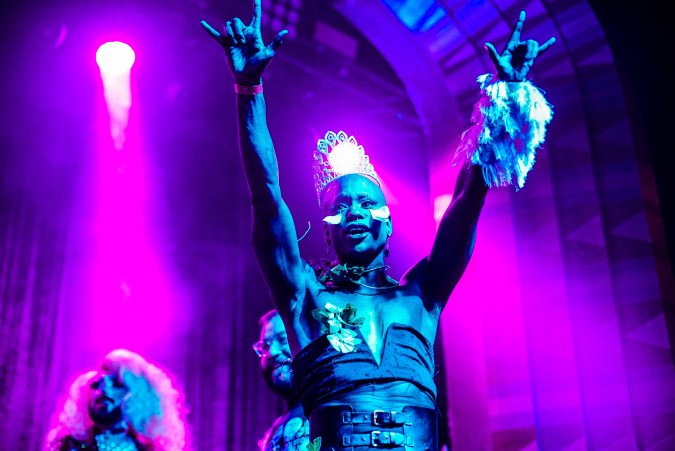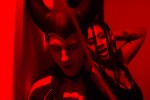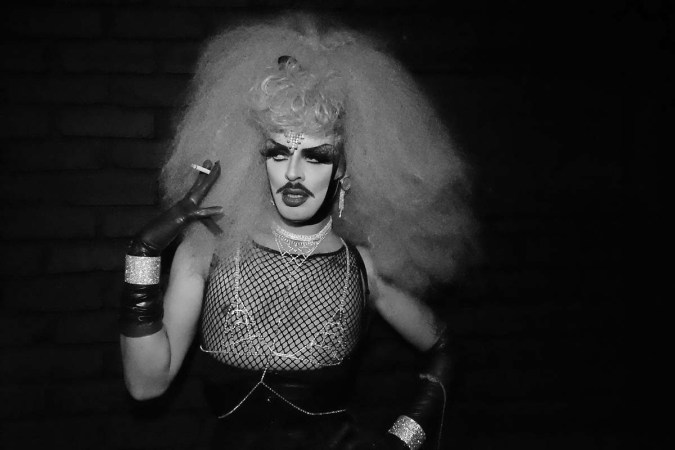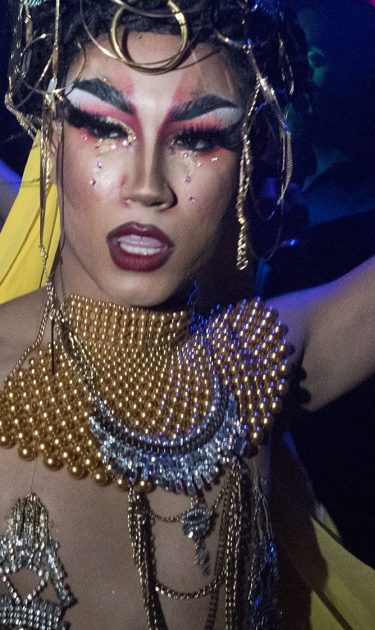By 11 p.m., one can expect to hear No Doubt’s “Sunday Morning” blaring at sCUM, the East Los Angeles punk party at the strip-mall bar in Chico in Montebello, California. The band’s song, like a clock, says two things: the drag show has yet to begin and although it’s still early, the night is steadily reaching its peak. Panadoimium is unleashed and the night begins to blur as a queen in a cow costume dances to a mix of “La Vaca” and “Moo!” It’s become a running joke to arrive right at this sweet spot of the night, when you catch the swell of young queer, mostly Latinx and black revelers arriving in clads of denim and leather – they’re there to see which brave body opens the circle to a Hole deep cut, flinging their bodies across the dance floor and calling to action a mosh pit. This all happens at the eleventh hour of the night.
Rudy Bleu and Hex-Ray Sanchez founders of sCUM have only one rule for the music: “No English pop music.” “There are exceptions, campy English songs like ‘Barbie Girl,’ but if we play pop music, it’s in Spanish like Mecano,” they tell Remezcla, while standing outside the venue. sCUM is not a party with strict genre lines; it’s a party where you hear how genres and styles of music intercept, how certain songs sharpen and gain a punk sensibility. The blantant queer smugness of Alaska’s y Dinamara’s 1986’s “A Quién le Importa” folds effortlessly into X’s “The World’s A Mess; It’s In My Kiss.” These songs animate the world sCUM creates every last Friday of the month, a world of rebellion and explicit queerness.
sCUM arrives from Bleu’s and Sanchez’s years at queer punk backyard shows called “Tea Parties.” Coming to age a decade apart, Bleu, 40, and Sanchez, 30, raised on punk adrenaline, saw reflections of themselves in one another. Bleu, a Los Angeles punk veteran with endless credits playing in bands, organizing punk shows and making zines, had not yet tailored a regular queer punk night. Sanchez had known and followed Bleu’s work, one day asking if he can send him his own zine. Bleu obliged and liked what he saw, and later asked Sanchez to hang out. The two resonated with one another’s sensibility, excited by what punk does to people and the worlds punk creates.

Bleu then invited Sanchez to DJ at his regular night, Mixtape at Silverlake’s Akbar, spinning nothing but punk and Spanish rock. The response was electric, affirming their pursuit for a regular queer punk night.

Thinking about where they could host the night, they thought about how much of nightlife in LA is predicated on how many miles of highway one is willing to go. In extremes Bleu, as a teenager, would take three buses for a show. For sCUM they wanted a “neighborhood party,” Sanchez says, “A lot of the people that came out for Jukebox were from East LA and its surrounding enclaves. We wanted to bring that here,” Bleu affirms. As East LA residents, they found an easy answer in Montebello’s gay bar Chico.
sCUM’s debut was godly. Its flier, created by Martin Crudo of bands Los Crudos and Limp Wrist, featured pasted cut-out-letters that spelled out its coordinates in the shape of a phallus. sCUM was initially proposed as a softer, sentimental night filled with Morrissey, New Wave and ‘80s night music, rather than punk’s freaky robustness, as the founders were nervous it would deter Alex, Chico’s manager from booking them again. sCUM upheld it’s promise; the bar was tightly packed with young Latinx and Black queers. Ecstatic about the turn out, Chico’s owner Alex offered them a monthly spot. sCUM since has become an LA nightlife staple, recently celebrating its third anniversary. On occasion, you’ll find punk icon Alice Bag in the DJ booth or LA musician San Cha drenched in glitter, performing alongside sCUM’s resident host Lady Forbidden.
sCUM offers a familial nostalgia — reminiscent of quinceañeras — widened by the possibility to act on a queer desire. sCUM is a safe haven for queers of color who tread through punk spaces often steeped in violent vibrados of sexism and homophobia.

“We fought over being the only gay at punk shows, like, ‘I’m the gay one!’ Eventually, we ended up at the same continuation school. We became homegirls.”
Before sCUM, Sanchez had met Forbidden at continuation school. “Me and Forbidden use to be enemies. We almost got down on Whittier Boulevard, in front of Little Caesars. We fought over being the only gay at punk shows, like, ‘I’m the gay one!’ Eventually, we ended up at the same continuation school. We became homegirls,” he says, laughing. Today, Lopez performs as Lady Forbidden, hosting sCUM’s daring performances which often find queens ripping latex dresses and dousing themselves in blood to the songs of Metallica. The club orchestrates perfect conditions for performers of all types: drag queens and performance artists to practice and test ideas. “We allow them to do everything and anything that is not against the law,” says Sanchez.
“To showcase what they can’t in other spaces like West Hollywood, where it’s frowned upon, sCUM becomes the place to get weird,” Sanchez explains.Last summer, for the film collective Dirty Look’s site-specific series “On Location,” artist Sebastain Hernandez paid tribute to East LA-raised titan Robert “Cyclona” Loretta at sCUM.
sCUM’s willingness to experiment has led them to host sCUM in San Francisco, New York and Mexico City. San Francisco – which is closest in geography – felt like an extension of Montebello. New Yorkers zoomed in on sCUM’s performances, posing cigarettes in hand and keeping it cool. It was Mexico City’s collaboration with Mami Slut, sharing sCUM’s appetite for absurdist performance, that proved to be the rowdiest stop. sCUM brought LA’s artists Rafa Esparza, Leather Papi (Gabriel Ruiz’s moniker) and San Cha as headliners to Mexico City. These collaborative club nights are partially orchestrated digitally. It’s never been easier to catch the beat of the coolest parties anywhere with an Instagram dive. Social media provides tools to control how to be seen and and ultimately remembered.

sCUM’s Instagram account features photos of the night, its performers and its attendants often in black and white – rendered as portraits to be remembered and studied. Sanchez and Bleu say they have a working archive, currently saving fliers and whatever ephemera they can grasp. sCUM’s importance doesn’t intimidate them. “It started as a party, and then we quickly realized it meant a lot to people. People would always come up to us! It was a trip to know people really needed this. It was important to acknowledge this was special, to take into consideration, and care about the people that are coming,” says Bleu. Both are surprised by how many revelers regularly bring in their own disposable cameras to catch a sliver of the night. This summer they’ll participate in Pasadena’s Armory Center for the Arts, showcasing archival materials and photography by a sCUM regulars such as Amina Cruz, Andrew Avila, Daniel Rodriguez, Martha Quintero and Anthony Mehlhaff.
“Essentially, sCUM isn’t about Ray and I. Anytime we have time to participate in things, we are just the people who organize. There are so many other people involved who actually are creating work,” says Bleu. It’s the preparation of and for the night that sets its stars ablaze.




